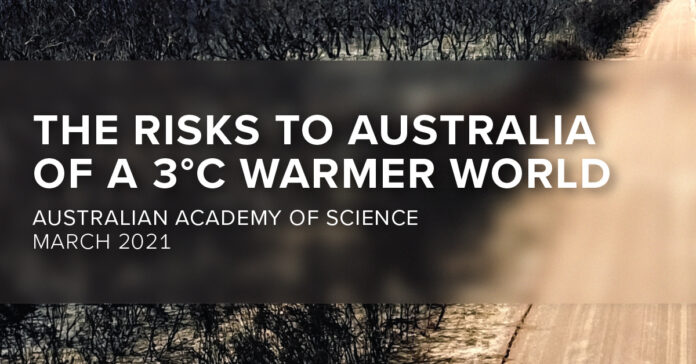A new just-published study entitled, “The risks to Australia of a 3°C warmer world,” looks at impacts to agriculture, forestry, fisheries, food security, natural ecosystems, cities, towns, and the health and wellbeing of the population. It picked the 3 Celsius (5.4 Fahrenheit) number based on current emission-reduction pledges from the global community which points to the planet exceeding the 1.5 to 2.0 Celsius (2.4 to 3.6 Fahrenheit) upper limit that was the target of the Paris Climate Agreement of 2015. The report doesn’t mince words stating “limiting climate change to 1.5 Celsius is now virtually impossible.”
Australia today is already 1.4 Celsius (2.5 Fahrenheit) warmer than it was in 1910. That’s awfully close to the lower limit established in Paris. In addition, the surrounding Pacific and Indian Oceans are both 1.0 Celsius (1.8 Fahrenheit) warmer than back at the beginning of the 20th century. And when you consider that Australia is already the driest of the inhabited continents (only Antarctica is drier even with all that ice), small differences in atmospheric temperature have a profound impact on rainfall, extreme weather, and groundwater resources.
In the 3 Celsius scenario by the turn of the next century, the neighbouring oceans will be far more acidic. Ocean oxygenation will diminish leading to dead zones. The impact on marine life will be negative and dramatic. The impact on coral reefs will yield an extinction-level event. The warmer ocean water volume will expand and will further be fed by melting ice from Antarctica with the likely result sea level rises of a half-meter or more by 2100, and much higher in subsequent centuries. With Australia’s major cities and most of its population living within close proximity to the ocean, saltwater intrusions will negatively impact wetlands, and freshwater aquifers and lead to significant coastal flooding.
As for the continent’s ecology, at 3 Celsius the report states it will be unrecognizable with major extinctions occurring among Australia’s unique marsupial, avian, and reptilian wildlife.
The report leaves no stone unturned in looking at other impacts including the threat to food production, health, and the wellbeing of the continent’s citizens. It forecasts that almost 90% of Australians will be affected by extreme heat conditions, bushfires, and severe storms. The energy supply infrastructure as it exists today will be insufficient to deal with the extreme stresses from extended heat waves and droughts.
The human impact from extreme heat will also be reflected by Australia’s agriculture sector with farms suffering from diminished water supply, heat-stressed livestock, and overall declines in yields. Already Australian farmers growing wheat and barley have seen a decline in profitability of 22% since 2000. If this trend continues the farms may cease to exist exacerbating food security.
Is there a plan of action to hold back these dire forecasts? Professor Lesley Hughes, a contributor to this report and Pro-Vice-Chancellor at Macquarie University believes that although the 1.5 Celsius goal is no longer achievable, “we should still be aiming for a stable global temperature below 2 Celsius.”
The report paints a way forward through policy actions that include:
- removing greenhouse gas (GHG) emissions from electricity generation and distribution
- electrifying the transport sector
- increasing energy efficiency and reducing emissions from industrial activities and buildings
- reducing non-energy related GHG emissions from industrial processes and agriculture
- implementing negative emissions options through biosequestration and technological means
- stopping deforestation and land degradation, and accelerating revegetation of cleared and degraded land
- shifting energy export industries to zero emissions as a matter of urgency.
In addition, the continent needs strategies to help its human and wildlife populations deal with extreme events. It needs negative emissions, not just a net-zero strategy. It needs to draw on the native knowledge of the Aboriginal community who preceded colonial settlement and has demonstrated an ability to adapt to Australia’s varying climate conditions over thousands of years. It needs to implement a plan to move its population away from vulnerable shorelines. And it needs to develop new technologies that will mitigate the worst extremes of climate change and allow for adaptation to the new circumstances of, hopefully, a world 2 Celsius warmer, and not 3.
Australian climate scientists have been fighting a war of words with the country’s Conservatives since 2013 when an elected climate-change-denying government began dismantling and defunding internal research programs. It led to the formation of a Climate Council crowd-funded by Australian citizens. Today a growing number of Australian cities and town governments are working with the Council through a partnership aimed at achieving some of the policies described above.
As for Australia’s current leadership, it continues to dither when it comes to meaningful carbon emissions reduction policy. On the government’s parliamentary website dealing with climate change, it begins by stating “climate policy continues to be controversial.”
In what way? It doesn’t say. Instead, it describes the mechanism that the current government has chosen to fight global warming. It is called the Emissions Reduction Fund which remains chronically underfunded and continues to demonstrate that it cannot produce any meaningful results to help the people and other continental denizens of Australia to adapt and mitigate the climate change that lies ahead.









